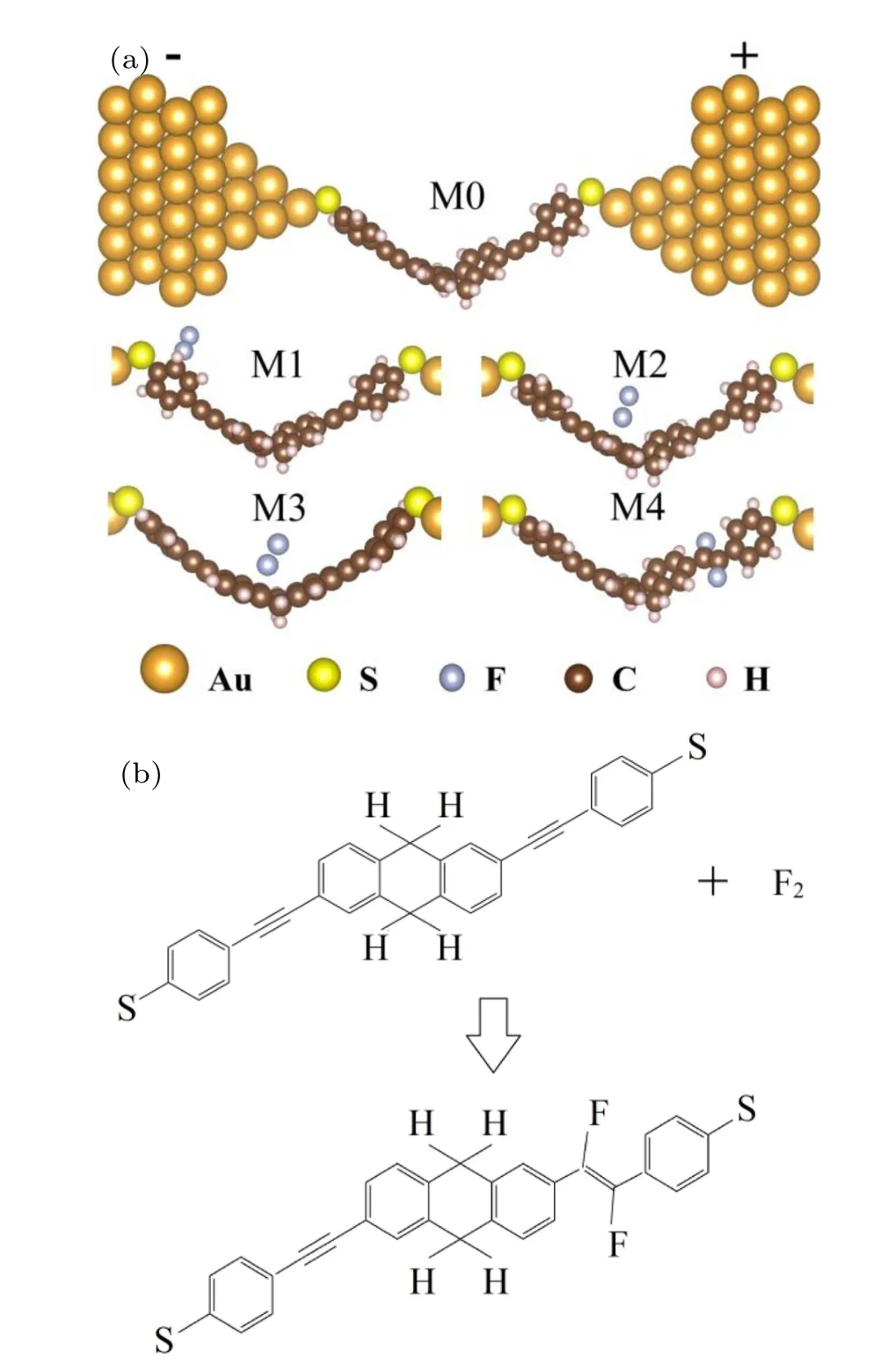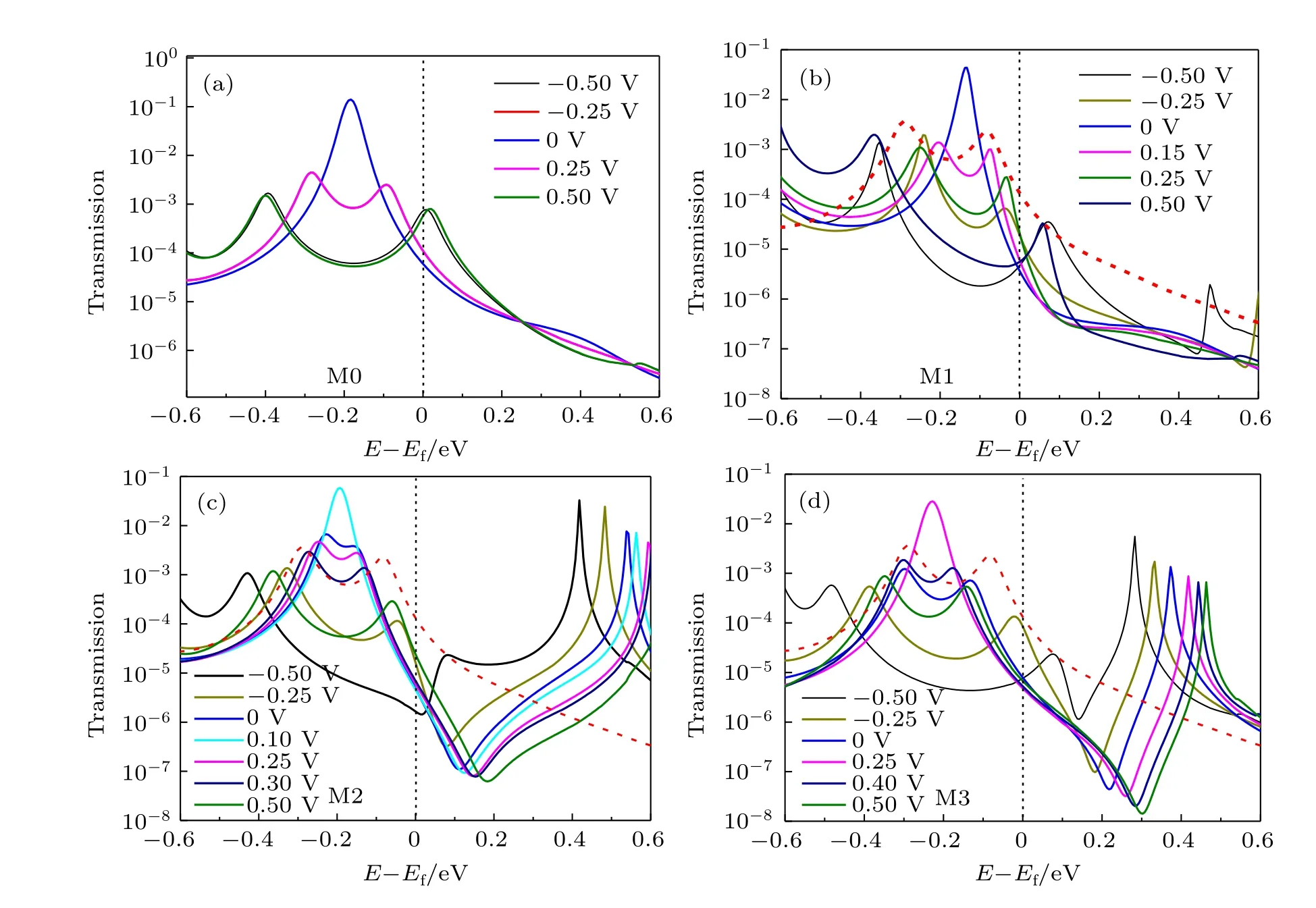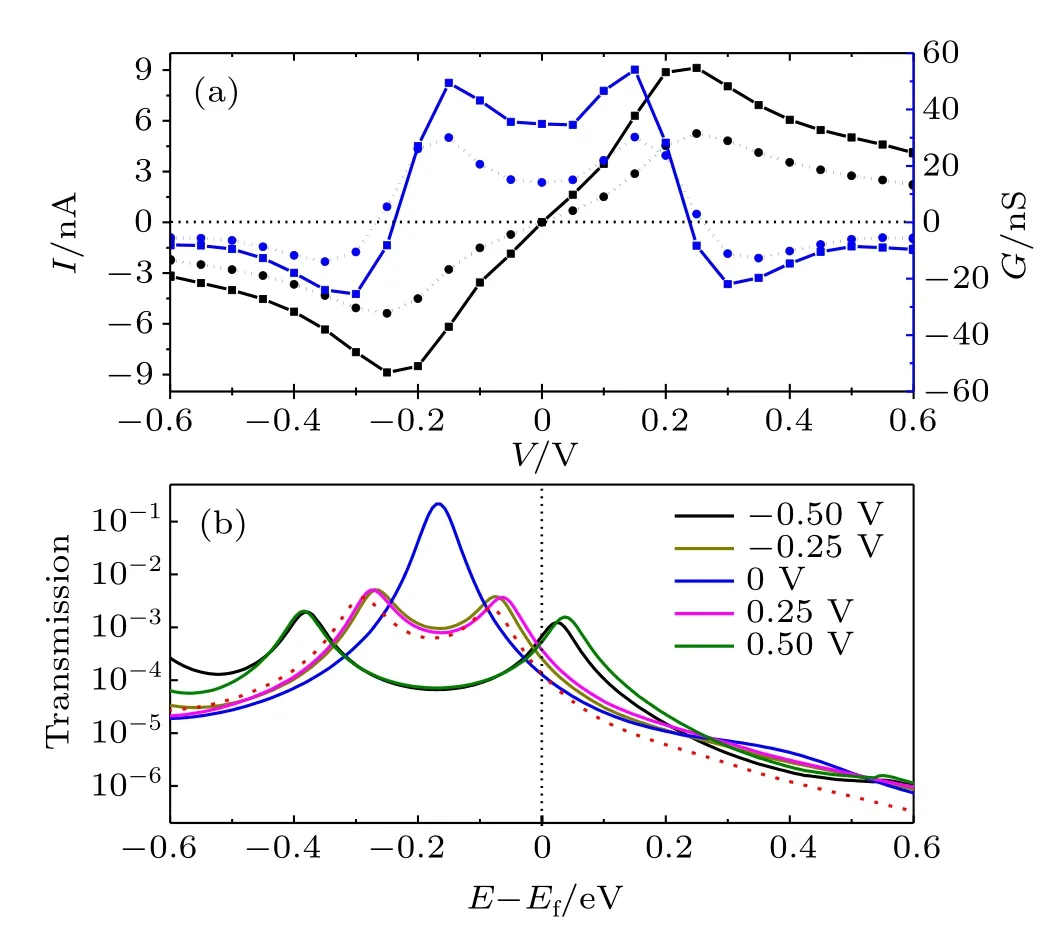Gas-sensor property of single-molecule device:F2 adsorbing effect∗
2017-08-30ZongLiangLi李宗良JunJieBi毕俊杰RanLiu刘然XiaoHuaYi衣晓华HuanYanFu傅焕俨FengSun孙峰MingZhiWei魏明志andChuanKuiWang王传奎
Zong-Liang Li(李宗良),Jun-Jie Bi(毕俊杰),Ran Liu(刘然),Xiao-Hua Yi(衣晓华),Huan-Yan Fu(傅焕俨), Feng Sun(孙峰),Ming-Zhi Wei(魏明志),2,and Chuan-Kui Wang(王传奎)
1 School of Physics and Electronics,Shandong Normal University,Jinan 250014,China
2 School of Materials Science and Engineering,Qilu University of Technology,Jinan 250353,China
Gas-sensor property of single-molecule device:F2adsorbing effect∗
Zong-Liang Li(李宗良)1,†,Jun-Jie Bi(毕俊杰)1,Ran Liu(刘然)1,Xiao-Hua Yi(衣晓华)1,Huan-Yan Fu(傅焕俨)1, Feng Sun(孙峰)1,Ming-Zhi Wei(魏明志)1,2,and Chuan-Kui Wang(王传奎)1
1 School of Physics and Electronics,Shandong Normal University,Jinan 250014,China
2 School of Materials Science and Engineering,Qilu University of Technology,Jinan 250353,China
The single thiolated arylethynylene molecule with 9,10-dihydroanthracene core(denoted as TADHA)possesses pronounced negative differential conductance(NDC)behavior at lower bias regime.The adsorption effects of F2molecule on the current and NDC behavior of TADHA molecular junctions are studied by applying non-equilibrium Green’s formalism combined with density functional theory.The numerical results show that the F2molecule adsorbed on the benzene ring of TADHA molecule near the electrode can dramatically suppresses the current of TADHA molecular junction.When the F2molecule adsorbed on the conjugated segment of 9,10-dihydroanthracene core of TADHA molecule,an obviously asymmetric effect on the current curves induces the molecular system showing apparent rectifier behavior.However,the current especially the NDC behavior have been significantly enlarged when F2addition reacted with triple bond of TADHA molecule.
molecular device,negative differential conductance(NDC),F2adsorption,gas-sensor effect
1.Introduction
Thanks to the rapid development of single-molecule technologies,[1–3]the molecular electronics have achieved great progresses in the last decade.[4–12]Nowadays,various kind of single-molecule junctions have been fabricated and lots of potential electronic performances have been found,[10–20]such as molecular switch,[3,13]molecular rectifier,[10–12]molecular transistor,[14–18]molecular sensor,[19]molecular memory,[3]etc.Some of these performances originate from nonlinear electron-transport properties of molecular junctions,[10,11]while others need the responses of the electronic transport to the external influence on the molecular devices.[14–19]Besides these performances,negative differential conductance(NDC)behavior is promised to have potential applications as switch,amplifier,memory,and so forth.[10,21–23]In order to understand and improve the underlying functional properties,different strategies are developed to tune the electronic transport properties of molecular devices.[24–32]The effects of molecule electrode interface,[33–36]electrode distance,[22,37]molecular anchor,[38–43]side group,[13,44]external field,[14–19,45]external ambient,[46–49]doping,[50–53]and contamination[54]have been studied intensively.Among those,small-molecule adsorbing or doping is an excellent choice by which the performance of molecular device can be modified selectively.[30,48–54]Generally,the dipolar molecule or oxidative molecule can be applied as small molecule to adsorb on the molecular device to tune the performance of the molecular device.[29,49,53–55]Recently,the single thiolated arylethynylene molecule with 9,10-dihydroanthracene core(denoted as TADHA)have been investigated experimentally by Perrin et al.[21]They found that,due to the non-conjugated 9,10-dihydroanthracene core separating two conjugated branches,the TADHA shows large NDC behavior at lower bias regime.Moreover,this low-bias NDC behavior can be modulated by electrode distance or dipolar adsorbate.[21,22,55]Motivated by Perrin’s and our work,in this paper,we particularly study the modulation effect of single F2molecule adsorbed on the backbone of TADHA molecule.Our studies show that,F2adsorbate shows different modulation effects on the electronic transport of TADHA molecular junction,such as enhancing or suppressing the current of molecular junction,or even inducing rectifier behavior when the F2adsorbed on different positions of TADHA molecule backbone.
2.Theoretical model and computational details
In order to investigate the adsorption effect of F2on TADHA molecular junction,we sandwiched TADHA molecule into the separation of two gold electrodes with F2adsorbed on different sites of TADHA molecule backbone to form Au-TADHA+F2-Au systems.Here we denoted the molecular junction without F2molecule as M0.After geometric optimizations,we found that there are four typical sites for F2molecule to be adsorbed on(see Fig.1):(i)the benzene ring site on one branch of TADHA molecule nearthe electrode,denoted as M1;(ii)one benzene ring site of 9,10-dihydroanthracene core near the triple bond,denoted as M2;(iii)one benzene ring site of 9,10-dihydroanthracene core near the non-conjugated segment,denoted as M3;(iv)triple bond site on one branch of TADHA molecule where the F2molecule reacted with C–C triple bond by addition reaction as shown in Fig.1(b),denoted as M4.Figure 1(b)shows that,for M4 molecular system,due to the addition reaction, one bond in the C–C triple bond has been broken and each of the two C atoms has been connected by one F atom.Consequently,the C–C triple bond has been converted into double bond.The geometries of TADHA molecular junctions with or without F2molecules were optimized with a maximum force of 0.02 eV/˚A in the SIESTA package.[56]The Troullier–Martin type norm-conserving pseudopotentials are applied to represent the core electrons,the generalized gradient approximation(GGA)with Perdew–Burke–Ernzerhof(PBE)formulation is applied as the exchange–correlation functional.[57]For Au atoms,a single-ζ plus polarization basis set is used,and for other atoms,a double-ζ plus polarization basis set is employed.

Fig.1.(color online)(a)Schematic structure of TADHA molecular junctions without or with F2 molecule adsorbed on different sites; (b)process of F2 molecule reacting with TADHA molecule by addition reaction with C–C triple bond.
According to the Landauer–Buttiker formula,[58]the current with different bias for the molecular junction is written as

where T(E,V)is the transmission probability.µLandµRare the electrochemical potentials of the two electrodes.The transmission probability T(E,V)is calculated by the NEGF method employing the TranSIESTA module of the SIESTA package.After current calculations,the differential conductance is obtained by G=∂I/∂V.In the electron transport calculations,the convergence criterion for density matrix was set to 1.0×10−4.A 4×4 k-point grid was used for the Brillouinzone(BZ)sampling in the transverse directions.
3.Results and discussion
The ground-state-geometry optimization of the molecular junctions shows that the affinities for F2molecule adsorbed as M1,M2,and M3 molecular systems are about 0.24,0.29,and 0.24 eV,which indicates that the F2molecules in M1,M2,and M3 molecular systems are physically adsorbed on the TADHA molecule since the affinities are much less than 1 eV.While for M4 molecular system that the F2is reacted with TADHA molecule by addition reaction on the C–C triple bond,the reaction energy is 5.11 eV.Thus for M4 molecular system,the F2is evidently chemically adsorbed on TADHA molecule since the adsorption/reaction energy is obviously larger than 1 eV and more than one order of magnitude larger than the affinities of M1,M2,and M3 system.Here the adsorption affinity and the reaction energy are both defined as

where EExtendedis the energy of Au-TADHA-Au extended molecular system,EF2is the energy of single F2molecule, and EComplexis the energy of each Au-TADHA+F2-Au complex molecular systems.

Fig.2.(color online)Electronic transport properties of TADHA molecular junction with one F2 molecule adsorbate.(a)Current and(b)differential conductance as functions of applied bias voltage.The inset in panel(a) shows the rectification ratios(R)of the molecular systems versus bias voltage.
Figure 2 shows the current and the differential conductance as functions of bias voltage for TADHA molecular junctions without or with F2adsorbate as M0,M1,M2,and M3 molecular systems.As shown by the experiment and our previous studies,[21,22]for the TADHA molecular junction without F2adsorbate(M0),the current shows peak value at about ±0.25 V,and the NDC behavior appears when the absolute value of the bias voltage is higher than 0.25 V,which is an excellent low-bias NDC behavior.When one F2molecule is adsorbed on TADHA molecule as M1,M2,and M3 systems, the currents in the lower bias regime are suppressed dramatically.Especially for the negative bias,the currents have been suppressed by more than one order of magnitude.However, forthe positive bias,the currents forthe M1,M2,and M3 obviously show different features.In detail,the current reaches the peak value swiftly at about 0.15 V and then decreases gradually in the lower bias regime.Correspondingly,the differential conductance and NDC are both very small for M1 junction. While for M2 and M3 systems,the currents reach their peak values at about 0.3 V and 0.4 V as well as the beginning bias of NDC behaviors,which are both larger than that of the system without F2molecule(M0 system).At the same time,the peak NDC values are also suppressed by the adsorption of F2molecule.It is noticeable that,the current curves of M2 and M3 show obvious rectifier features with the maximal rectif ication ratio up to 12.5 and 9.9,respectively,which is only 2.3 for M1 molecular system(see the inset of Fig.2).
In order to understand the adsorption effect of F2molecule on TADHA molecular system,we presented the transmission spectra for the bias voltages of 0.0 V,±0.25 V, ±0.5 V,and the voltage of peak-current in Fig.3.The NDC behavior of TADHA molecular junction without F2adsorbate mainly due to the Stark effect of applied bias voltage which separated the degeneration of the highest occupied molecular orbital(HOMO)and HOMO-1.At zero bias,both HOMO and HOMO-1 are delocalized orbitals.After the separation of the degeneration,the HOMO and HOMO-1 are only localized on one branch of the TADHA molecule respectively(Fig.4), which correspondingly splits the high transmission peak located at−0.19 eV into two lower peaks(Fig.3(a)).When the F2molecule is adsorbed on TADHA molecule as M1,M2, and M3,in the lower negative bias regime,the transmission spectra shows similar character,that is,the transmission peaks corresponding to the HOMO shrink swiftly with the increase of the negative bias.Thus,in the lower negative bias regime, the currents of M1,M2,and M3 systems are very weak.

Fig.3.(color online)Transmission spectra of TADHA molecular junctions.(a)Transmission spectra of TADHA molecular junction without F2 adsorbate;(b)–(d)transmission spectra of TADHA molecular junction with one F2 adsorbate as M1,M2,and M3 molecular systems that are shown in Fig.1.The red dashed lines in panels(b)–(d)are the transmission spectra of TADHA molecular junction without F2 adsorbate at 0.25 V bias voltage,which are used as reference curves in the four figures.
However,the transmission spectra show obvious differences for these three molecular systems at zero bias or in the positive bias regime.Figure 3(b)shows that,there is a high transmission peak at−0.14 eV for M1 molecular system, which is attributed to the two degenerated molecular orbitals of HOMO and HOMO-1.However,for M2 and M3 molecular systems,due to the separation of HOMO and HOMO-1 by the adsorption of F2molecule,the transmission spectra show two peaks in the region of−0.4∼−0.1 eV,which indicates that F2molecule adsorbed on the benzene ring site of 9,10-dihydroanthracene core destroys the degeneration of the HOMO and HOMO-1.However,with positive bias being applied,the HOMO is depressed,and at the same time the HOMO-1 is enhanced by bias,thus for M2 system,these two orbitals are re-degenerated and the transmission spectrum shows one high peak at 0.19 eV with bias of 0.10 V;for M3 system,the HOMO and HOMO-1 are re-degenerated and two corresponded transmission peaks are combined into one high peak at 0.23 eV with bias of 0.25 V.Attribute to the redegeneration of the HOMO and HOMO-1 at positive bias,the transmission spectra shrinking speeds are obviously slower for positive bias than for negative bias for M2 and M3 molecular systems.Thus,the M2 and M3 molecular systems show obvious rectifier behavior.

Fig.4.(color online)Spatial distributions of HOMOs and HOMOs-1 for TADHA molecular junctions without or with F2 molecule,where the orbital energies relative to the Fermi level are also shown under each orbital.
To gain deep insight into electronic transport properties of TADHA molecular junctions with or without F2adsorbates, we show spatial distributions of the HOMOs and HOMOs-1 for M0,M1,M2,and M3 molecular systemsat0.0 V,−0.25 V, ±0.5 V,and at the peak-current voltages in Fig.4.The figure shows that,at zero bias,the HOMOs and HOMOs-1 are well delocalized over the whole TADHA molecule for M0 and M1 molecular systems.However,for M3 molecular system,The HOMO and HOMO-1 are almost localized on one branch of TADHA molecule.With the increase of the positive bias,the HOMO and HOMO-1 are re-delocalized at about 0.10 V and 0.25 V respectively for M2 and M3 molecular junction.One can see that,the F2adsorbed on the core of TADHA molecule have larger influence on the frontier molecular orbitals than that of F2adsorbed on the benzene ring near electrode.When lower negative bias(e.g.,−0.25 V)is applied,due to the Stark effect,the HOMO and HOMO-1 are mainly localized on right or left branches respectively for M0,M1,M2,and M3 molecular system.However,the distribution of HOMO for M0 system shows an apparent difference from those of M1,M2,and M3 systems.In detail,a small proportion for the HOMO distributes on the left arm of TADHA molecule for M0 system. While for M1,M2,and M3 systems,due to the adsorptions of F2molecule,the distributions of HOMO on the left benzene ring are negligible.Thus,one can understand why the currents in the lower negative bias regime are very weak for M1,M2, and M3.For positive bias,such as 0.30 V for M2 system and 0.40 V for M3 system,although the HOMOs mainly distribute on the left branch of TADHA molecule,there are also a small proportions on the right arm.Hence,the M2 and M3 molecular system are more conductive than M1 molecular system in the positive bias regime and present obvious rectifier behavior.

Fig.5.(color online)Electronic transport properties of the molecular junction for the triple bond of TADHA molecule being fluoridated by F2 molecule.(a)Current and differential conductance as functions of applied bias voltage.(b)Transmission spectra for fluoridated TADHA molecular junction at different bias voltage.The dashed lines in panel(a)are the corresponding curves of TADHA molecular junction without F2 adsorbate,and the red dashed line in panel(b)is the transmission spectrum of TADHA molecular junction without F2 adsorbate at 0.25 V,which are used as reference curves in the figures.
Different from M1,M2,and M3 molecular system, when F2molecule reacts with TADHA molecule by addition reaction on the triple bond as M4 molecular system,the current and the NDC behavior are both enhanced dramatically. Figure 5(a)shows that except for the current value being enlarged by a factor of about 1.8,the variation trend of the current curve as well as the differential conductance curve of M4 molecular system are changed very slightly.Meanwhile,the peak NDC value is also doubled by the addition reaction of F2molecule.From Fig.5(b)one can see that,the transmission features of M4 system are very similar to those of M0 system. The main difference is the transmission spectra near the Fermi energy being enhanced a little,which is due to the fact the HOMO and HOMO-1 are slightly raised by the reaction of F2.
4.Conclusions
Based on density functional theory and NEGF method, the F2adsorption effects on the electron-transport properties and NDC behavior of TADHA molecular junctions are investigated theoretically.It is shown that F2molecule adsorbed on the conjugated part of TADHA molecule can suppress the current and the NDC behavior of the molecular systems asymmetrically which further induces the molecular system showing apparent rectifier behavior,especially for the F2molecule on the conjugated segment of 9,10-dihydroanthracene core of TADHA molecule.However,the current and the NDC behavior have been dramatically enlarged when F2addition reacted with triple bond of TADHA molecule.
[1]Cui X D,Primak A,Zarate X,Tomfohr J,Sankey O F,Moore A L, Moore T A,Gust D,Harris G and Lindsay S M 2001 Science 294 571
[2]Xiang D,Jeong H,Lee T and Mayer D 2013 Adv.Mater.25 4845
[3]Wang Q,Liu R,Xiang D,Sun M,Zhao Z,Sun L,Mei T,Wu P,Liu H, Guo X,Li Z L and Lee T 2016 ACS Nano 10 9695
[4]Jiang J,Kula M and Luo Y 2006 J.Chem.Phys.124 034708
[5]Zhang X J,Chen K Q,Tang L M and Long M Q 2011 Phys.Lett.A 375 3319
[6]Liu R,Wang C K and Li Z L 2016 Sci.Rep.6 21946
[7]Dou K P,Fu X X,De Sarkar A and Zhang R Q 2016 Nano Res.9 1480
[8]Zhang X J,Chen K Q,Long M Q,He J and Gao Y L 2015 Mod.Phys. Lett.B 29 1550106
[9]Li Z L 2011 Chin.J.Chem.Phys.24 194
[10]Zhang Z,Guo C,Kwong D J,Li J,Deng X and Fan Z 2013 Adv.Funct. Mater.23 2765
[11]Hu G C,Zhang Z,Li Y,Ren J F and Wang C K 2016 Chin.Phys.B 25 057308
[12]Zhang G P,Wang S,Wei M Z,Hu G C and Wang C K 2017 J.Phys. Chem.C 121 7643
[13]Fu X X,Zhang L X,Li Z L and Wang C K 2013 Chin.Phys.B 22 028504
[14]Xu B Q,Li X L,Xiao X Y,Sakaguchi H and Tao N J 2005 Nano Lett. 5 1491
[15]Li Z L,Zhang G P and Wang C K 2011 J.Phys.Chem.C 115 15586
[16]Li Z L,Fu X X,Zhang G P and Wang C K 2013 Chin J.Chem.Phys. 26 185
[17]Su W,Jiang J,Lu W and Luo Y 2006 Nano Lett.6 2091
[18]Xiang D,Jeong H,Kim D,Lee T,Cheng Y,Wang Q and Mayer D 2013 Nano Lett.13 2809
[19]Xu B Q,Xiao X Y,Yang X M,Zang L and Tao N J 2005 J.Am.Chem. Soc.127 2386
[20]Wang F Y and Li G Q 2016 Chin.Phys.B 25 077304
[21]Perrin M L,Frisenda R,Koole M,Seldenthuis J S,Gil J A C,Valkenier H,Hummelen J C,Renaud N,Grozema F C,Thijssen J M and Dulić D 2014 Nat.Nanotech.9 830 2014 Nat.Nanotech.9 830
[22]Yi X H,Liu R,Bi J J,Jiao Y,Wang C K and Li Z L 2016 Chin.Phys. B 25 128503
[23]Li Y H,Yan Q,Zhou L P and Han Q 2015 Acta Phys.Sin.64 057301 (in Chinese)
[24]Xiang D,Zhang Y,Pyatkov F,Offenhäusser A and Mayer D 2011 Chem.Commun.47 4760
[25]Xu B Q and Tao N J 2003 Science 301 1221
[26]Liu R,Bao D L,Jiao Y,Wan L W,Li Z L and Wang C K 2014 Acta Phys.Sin.63 068501(in Chinese)
[27]Zhang Y F,Yi X H,Zhang Z,Sun J X and Li Z L 2015 J.At.Mol.Sci. 6 263
[28]Xiang D,Lee T,Kim Y,Mei T T and Wang Q L 2014 Nanoscale 6 13396
[29]Zhao W K,Cui B,Fang C F,Ji G M,Zhao J F,Kong X R,Zou D Q, Jiang X H,Li D M and Liu D S 2015 Phys.Chem.Chem.Phys.17 3115
[30]Song Y,Xie Z,Ma Y,Li Z L and Wang C K 2014 J.Phys.Chem.C 118 18713
[31]Zou D,Zhao W,Fang C,Cui B and Liu D 2016 Phys.Chem.Chem. Phys.18 11513
[32]Wang S,Wei M Z,Hu G C,Wang C K and Zhang G P 2017 Org. Electron.49 76
[33]Zhao W K,Ji G M and Liu D S 2014 Phys.Lett.A 378 446
[34]Li Y,Zhang G P,Xie Z,Zhang Z,Ren J F,Wang C K and Hu G C 2016 Chin.J.Chem.Phys.29 344
[35]Jiang Z L,Wang H,Shen Z Y,Sanvito S and Hou S M 2016 J.Chem. Phys.145 044701
[36]Hu G C,Zuo M Y,Li Y,Zhang Z,Ren J F and Wang C K 2015 Chin. Phys.B 24 077308
[37]Zhang G P,Hu G C,Song Y,Xie Z and Wang C K 2013 J.Chem.Phys. 139 094702
[38]Li M J,Xu H,Chen K Q and Long M Q 2012 Phys.Lett.A 376 1692
[39]Hong W,Manrique D Z,Moreno-Garcia P,Gulcur M,Mishchenko A, Lambert C J,Bryce M R and Wandlowski T 2012 J.Am.Chem.Soc. 134 2292
[40]Hong W,Li H,Liu S X,Fu Y,Li J,Kaliginedi V,Decurtins S and Wandlowski T 2012 J.Am.Chem.Soc.134 19425
[41]Bao D L,Liu R,Leng J C,Zuo X,Jiao Y,Li Z L and Wang C K 2014 Phys.Lett.A 378 1290
[42]Chen F,Li X,Hihath J,Huang Z and Tao N 2006 J.Am.Chem.Soc. 128 15874
[43]Yokota K,Taniguchi M,Tsutsui M and Kawai T 2010 J.Am.Chem. Soc.132 17364
[44]Xiang D,Pyatkov F,Schröper F,Offenhäusser A,Zhang Y and Mayer D 2011 Chem.Eur.J.17 13166
[45]Na J S,Ayres J,Chandra K L,Gorman C B and Parsons G N 2007 Nanotech.18 424001
[46]Cao H,Ma J and Luo Y 2010 Nano Res.3 350
[47]Lin X N,Zhang G P,Ren J F,Yuan X B and Hu G C 2014 Acta Phys. Sin.63 068502(in Chinese)
[48]Li Z L,Li H Z,Ma Y,Zhang G P and Wang C K 2010 Chin.Phys.B 19 067305
[49]Long D P,Lazorcik J L,Mantooth B A,Moore M H,Ratner M A, Troisi A,Yao Y X,Ciszek J W,Tour J M and Shashidhar R 2006 Nat. Mater.5 901
[50]Zou D Q,Song Y,Xie Z,Li Z L and Wang C K 2015 Phys.Lett.A 379 1842
[51]Tian W,Yuan P F,Yu Z L,Tao B K,Hou S Y,Ye C and Zhang Z H 2015 Acta Phys.Sin.64 046102(in Chinese)
[52]Chen Y,Hu H F,Wang X W,Zhang Z J and Cheng C P 2015 Acta Phys. Sin.64 196101(in Chinese)
[53]Yang Z,Lang N D and Di Ventra M 2003 Appl.Phys.Lett.82 1938
[54]Zhang Z H,Deng X Q,Tan X Q,Qiu M and Pan J B 2010 Appl.Phys. Lett.97 183105
[55]Li Z L,Yi X H,Liu R,Bi J J,Fu H Y,Zhang G P,Song Y Z and Wang C K 2017 Sci.Rep.7 4195
[56]Brandbyge M,Mozos J L,Ordejn P,Taylor J and Stokbro K 2002 Phys. Rev.B 65 165401
[57]Perdew J P,Burke K and Ernzerhof M 1996 Phys.Rev.Lett.77 3865
[58]Buttiker M,Imry Y,Landauer R and Pinhas S 1985 Phys.Rev.B 31 6207
6 June 2017;revised manuscript
30 June 2017;published online 11 August 2017)
10.1088/1674-1056/26/9/098508
∗Project supported by the National Natural Science Foundation of China(Grant No.11374195),the Taishan Scholar Project of Shandong Province,China,and the Jinan Youth Science and Technology Star Project,China(Grant No.201406004).
†Corresponding author.E-mail:lizongliang@sdnu.edu.cn
©2017 Chinese Physical Society and IOP Publishing Ltd http://iopscience.iop.org/cpb http://cpb.iphy.ac.cn
猜你喜欢
杂志排行
Chinese Physics B的其它文章
- Relationship measurement between ac-Stark shift of 40Ca+clock transition and laser polarization direction∗
- Air breakdown induced by the microwave with two mutually orthogonal and heterophase electric field components∗
- Collective motion of active particles in environmental noise∗
- Temperature dependence of heat conduction coefficient in nanotube/nanowire networks∗
- Analysis of dynamic features in intersecting pedestrian flows∗
- Heat transfer enhancement in MOSFET mounted on different FR4 substrates by thermal transient measurement∗
